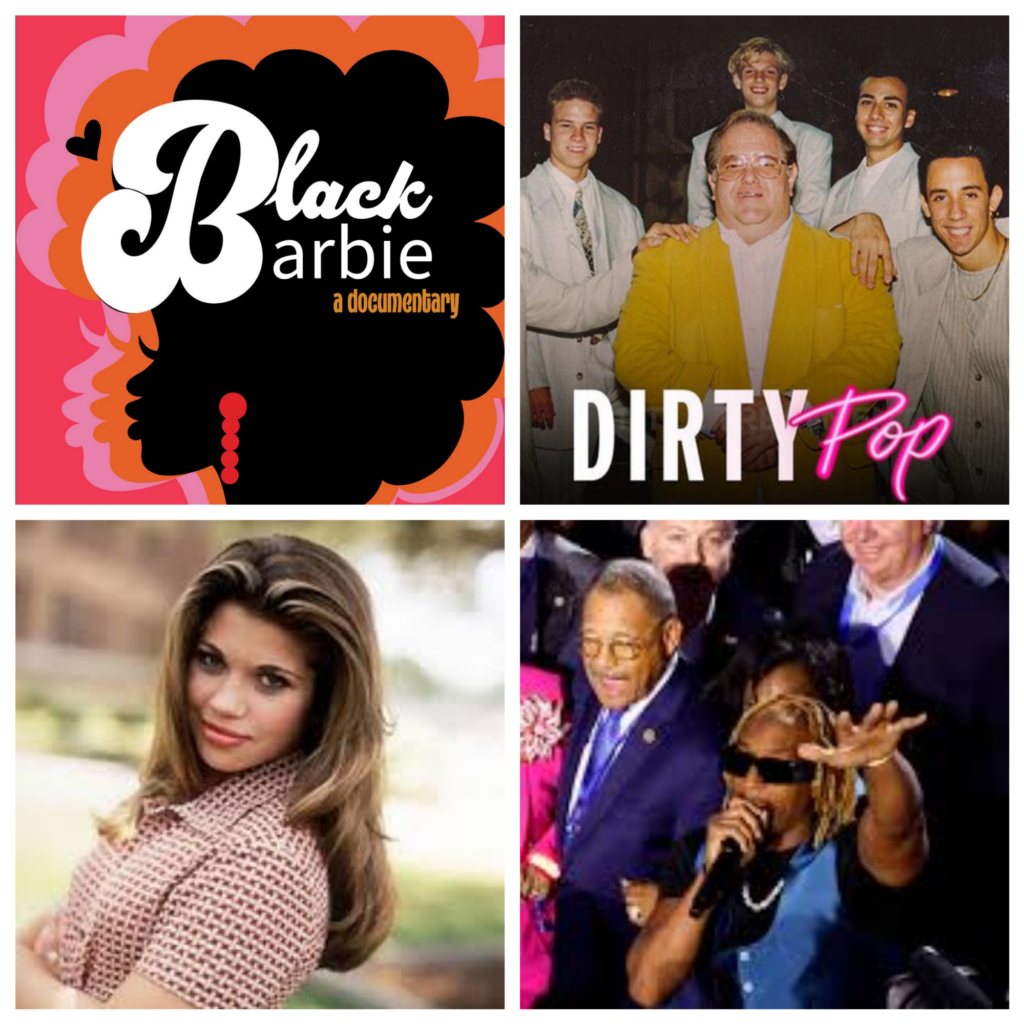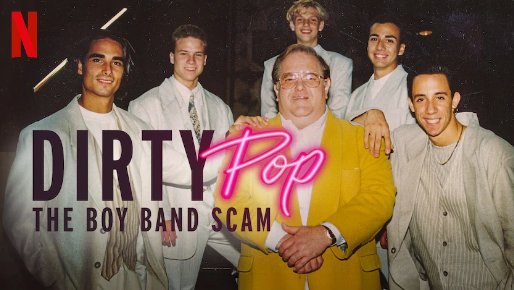
Not a good week. Not a good week at all. But we’re not here to talk about that. Nope, we’ve got Pop Culture to discuss!

I guess I was on my Documentary Bullshit this week, as I found myself watching two very different ones, on two very different topics. First up was Black Barbie: A Documentary, on Netflix, about the introduction of the Black Barbie doll. My wife is really into documentaries lately, and as she was scrolling, I told her to stop on this one. I didn’t have a ton of interest in it, but I love toys, and it was there. Still, the girls were still awake, and they kept talking, so I wasn’t really getting anything out of it. I left and went to Target, as one does on a Friday night. When I got home, I found that I was still curious about the thing, so I restarted it. The girls heard me come home, and came down to join me. My youngest fell asleep pretty quickly, but I was surprised to see how engrossed my oldest had become in the whole film.
Let’s just say I learned A LOT from this documentary. For instance, I didn’t realize I’m just a tad older than Black Barbie herself, as I guess I assumed the doll had been made, begrudgingly, in the late 60s, early 70s. Not true! The first Black Barbie wasn’t released in 1979, though Black dolls had been created by other companies prior to that. They touched on things like the Clark Study, where Black kids were shown dolls of different races, but they gravitated to the White dolls because it had been ingrained in them that the White dolls were prettier. They went on to show the other Black dolls Mattel had dabbled in, such as the Shani line and Barbie So In Style. Even when Black dolls were introduced to the line, they were always satellite characters – friends of Barbie. So, they were never the main character, and more of an accessory. So, it was a symbolic move when Mattel said, “No, a Black girl can be Barbie, too.”
The film also sort of bumped up against the 2021 animated movie Barbie: Big City, Big Dreams. Ya see, Barbie may have gotten a big theatrical lie action film recently, but they’ve been cranking out computer animated direct to video features for over a decade. I know because I’ve had to watch MANY of them. The 39th (!) release, Big City, Big Dreams is interesting because it introduces a Black Barbie Roberts. Ya see, “White Barbie”, as we’ll call her here, is accepted to a prestigious performing arts school in NYC. When she gets to her dorm – with “Barbie Roberts” on the door – she is met by a Black girl, who says her name is Barbie Roberts. TWO Barbie Robertses?! Since Black Barbie is a local, from Brooklyn, White Barbie comes up with a solution: “We’ll call you ‘Brooklyn’!” So, for the rest of the movie, Black Barbie is introduced to everyone as “Brooklyn”, and she’s just fine with it. Barbie must be a Highlander, as I suppose There Can Only Be One. I watched that movie when it was released (There were some dark days during Covid!), where it bothered me then, and it bothers me now. The documentarians spoke with the head of Mattel DEI, who does a lot of stuttering to justify the existence of “Brooklyn”, as he insists they’re building a whole line around just her. The problem here, however, is even he fails to realize that by stripping her of her true name, there’s just more “Othering” going on with Black Barbie. It takes away the one thing Black Barbie had accomplished: Showing Black girls that they, too, could be the main character.
I didn’t expect the documentary to affect me as much as it did. I’m always kind of cynical with race stuff, because I’ve grown up in a particular time, and I’ve been fortunate. Sometimes, I think “Folks were really dumb enough to treat people differently due to skin color? The same people who spend good money to gain skin color?!” Naive, I know. I mean, it remains to this day, and still feels just as crazy to me. So, I went into this film with a pretty cynical mindset. After all, I once did an interview with New York Magazine about Miles Morales, where I said I never looked to him as “representation”, because I never felt I needed that in my entertainment (Unsurprisingly, my contribution would be cut from the final article). However, to hear these Black celebrities, such as TV megaproducer Shonda Rhimes and U.S. Representative Maxine Waters, discuss how impactful the doll’s introduction was to their development of self, and feelings of self worth…I couldn’t be cynical about that. I just had to admit that I never understood, but I do now.
And it also led to some valuable discussions. Some of y’all don’t know me “in real life”, but my daughters are biracial. So, when it was over, I was surprised how my oldest wanted me to get on eBay and look up Black Barbies. I mean, sure, all kids want toys, but she actually had an interest in these things, where she has never really been my Doll Daughter. She was fascinated by the other dolls mentioned, like the Barbie So In Style, and I had to tell her “I worked at Toys ‘R’ Us when these were out, and they were not out long. This was not a line that Mattel supported!” But something about the documentary lit a fire in her. A weird thing with biracial kids is you never quite know how they’re going to identify. Back in my day, we subscribed to The One Drop Rule. Now, I kinda lean on the question of “Well, what race do you think a cop is gonna take you for if they see you in a poorly lit area?” My girls are very much “I’m half Black, and half White.” So, I asked her if she ever felt poorly represented in media, and how she felt being half and half. She had a pretty mature answer, saying that she felt it just gave her more opportunities. So, I didn’t go into that evening expecting that discussion, but I’m glad it was had. And, for that, I give Black Barbie: A Documentary the highest marks!

Next up, Lindsay and I watched Dirty Pop: The Boy Band Scam. I was originally supposed to watch this as homework for a podcast appearance, but I was probably already gonna watch it because, well, boybands. If you’re not familiar, it’s a 3-part Netflix series about boyband impresario and Ponzi scheme architect Lou Pearlman. If you’re new here, I’m BIG into boybands. Hell, I like to think of myself as the biggest straight boyband fan in North America (Not the world, though – Europe’s got some crazies!). And, by this point, there have been quite a few docuseries on Pearlman, as he boiled the creation of boybands down to a science. Since there have been so many, however, I wondered if there was anything left to learn about Pearlman. Didn’t I know it all by now?
First of all, the documentary had a weird framing device, where they used AI to make it seem like Lou was speaking to the viewer, when the AI was actually moving his mouth along to text from his book, Bands, Brands, and Billions: My Top Ten Rules for Success. Given that he’s been dead for a few years, some viewers found this unsettling, but it really didn’t bother me that much. To me, what set this apart from the other docs I’d seen on Pearlman was that it had the participation of actual success stories. Usually, there’d be a few members of Lou’s lesser groups, like Take 5 and LFO, but this one had participation by *NSYNC’s Chris Kirkpatrick, as well as Backstreet Boys AJ McLean and Howie Dorough. I mean, Lance Bass did a Lou documentary, and I don’t even remember him having Chris Kirkpatrick on there – and they were in the same group! Anyway, I didn’t learn much from this new presentation, other than the fact that Howie kept attending Lou’s parties, even after his band sued him to get out of their contract. He always felt an obligation to Lou, recognizing that, for all his faults, there would have been no Backstreet Boys without him.
I was more struck by how many things the documentary glossed over. It never seems to come up in these things – whether due to NDAs or whatever – but the lineups we know as *NSYNC and Backstreet Boys are NOT the original lineups. There are a handful of dudes out there, pumping gas, pissed off they “fumbled the bag”. Google “Phoenix Stone”. I don’t know why these things always ignore those guys, because I feel like it would show that these things had to be fine tuned, and weren’t just “lightning in a bottle”. Lou would mix groups around, putting some guys in one, and moving some to others. Because all of these guys were in Orlando, they already traveled in the same circles. Kirkpatrick claimed he started *NSYNC, and refers to himself as its “founder”, but it was Lou who made that actually mean something. Also, considering Lou was a gross older man, there were always rumors of sexual impropriety between he and the band members. I mean, he surrounded himself with hot teenage boys. A few of the talking heads took the “I never saw anything, but my thoughts are with the victims if anything did take place” approach. Sure, Jan. Seeing as how most Lou-centric things make that a big priority (It was basically the thesis of Bass’s doc), this one was just kinda like “I mean…I dunno about all that…” They even talked to Lou’s “girlfriend”. I put it in quotes because she was really just his nurse, but he used her as a beard for social functions, and she ate it up because he bought he expensive items. In one of the many books I’ve read, they go on to say she was with him for about 7 years, and never went further than the one time he tried to kiss her. None of that is really discussed in any detail in this documentary, though.
When it was over, I couldn’t decide if 3 episodes were too much or too little. They really only sort of skim the surface, though they had more than enough time to do some digging. I also would have liked more anecdotal stuff from the members of these boybands. You don’t get much dirt from the big names, while the most interesting stuff comes from a former member of Natural, who was Lou’s “business partner” after his group fell apart. It turns out Lou was actually on the run from the feds, and using the former boybander to finance his escape.
But the doc also takes a strange turn in episode 3, as it posits a theory I’d never heard before: Lou was so obsessed with being a Big Shot (having seen the celebrity life lived by his cousin Art Garfunkel) that he had gotten into bed with some Very Bad People. He allegedly never made as much off the boybands as folks assumed, because he had leveraged everything to BMG just to get them to take a chance on Backstreet Boys. So, instead of “Lou stole all the money that the boybands made”, the documentary went on to suggest that the bands never made as much as we thought, and Lou was actually paying them a sizable portion of the meager proceeds he was receiving after everyone else was paid. So, he lived his extravagant life on promises and forged checks. But none of this could be proven because it seemed like all of his bank records were forged. So, all of his schemes – including the life insurance Ponzi scheme – were designed to finally get him out of the hole and pay back the people the everyone felt he had wronged. I phrased it that way because those close to him would say that, even in prison, he never seemed to think what he had done was wrong. Many said they believed he totally thought he would eventually be able to get right, and everyone would get their money. If anything, he just saw it as they had invested in a risky gamble, that may have looked like it hadn’t paid off, but he would have made them whole. Interesting theory, but I’m not buying it.
Things You Might Have Missed This Week
- TNT Remembers Drama? In a very strange move, TNT has picked up The Librarians: The Next Chapter, just a week after it was mysteriously pulled from The CW’s Fall schedule.
- We don’t “do death” here, but I’ve got to give a shout to Phil Donahue, who passed away this week. For you young’uns, he pretty much pioneered the modern daytime talk show format. Without him, there’d be no Oprah, Jenny Jones, Ricki Lake, etc.
- Former Boy Meets World actress/current podcaster Danielle Fishel announced she had been diagnosed with a very early stage of breast cancer. It won’t be the first time I’ve prayed about Topanga’s breasts, and it probably won’t be the last…
- Star Wars: The Acolyte has been canceled after one season, which is weird because Star Wars is one of those franchises where things rarely get officially *canceled*, but are rather quietly buried til folks forget they’d ever been announced. Anyway, some folks are happy, others are sad. I don’t know who “The Good Guys” are here.
- Taylor Swift released the video for her latest single, I Can Do it With A Broken Heart”. It’s a tour footage video, which I think is the laziest type of music video you can make. Not like it matters to Swifties, though.
- Katey Sagal is replacing Jamie Lee Curtis in the live action One Piece, but unless it’s the redhead in the bikini, I’m not interested.
- There are reports that Paul Rudd and Jack Black are in talks to star in a reboot of Anaconda. They’re really abusing the goodwill Rudd has established with audiences!
- That squinty gymnast (That sounds like a Wes Anderson movie), Stephen Nedoroscik, has been announced as the first contestant for the next season of Dancing With The Stars
- She’s Jenny from the chopping block, as that marriage is OVER! JLo filed for divorce from Ben Affleck, and I think we’re all feeling for our dude, saying “Man, we never liked her anyway.”

Who had a great week? I mean, it sure as Hell wasn’t ME! I know the Democratic National Convention was this week, but I’m not feeling the political circus right now. But folks did love seeing Lil Jon. Should we give it to Lil Jon? I think I’m gonna say “YEAH!” Or, rather, “Ya-yuh!” Lil Jon had the West Week Ever.



